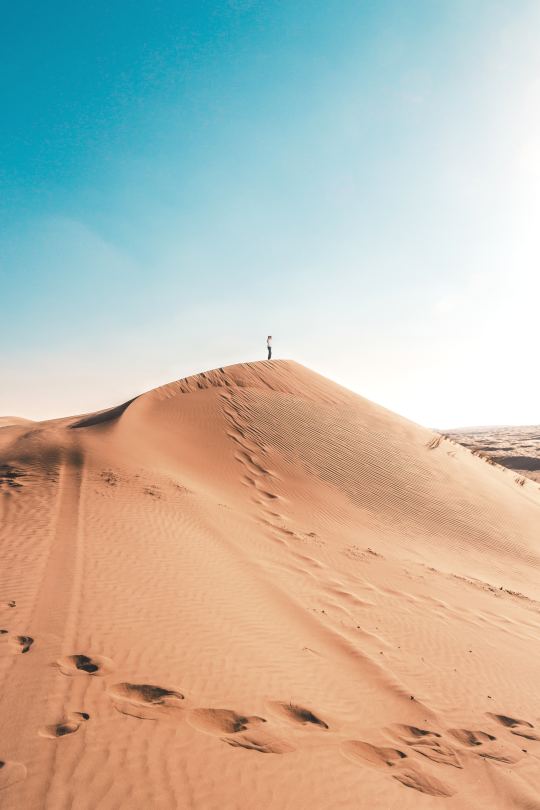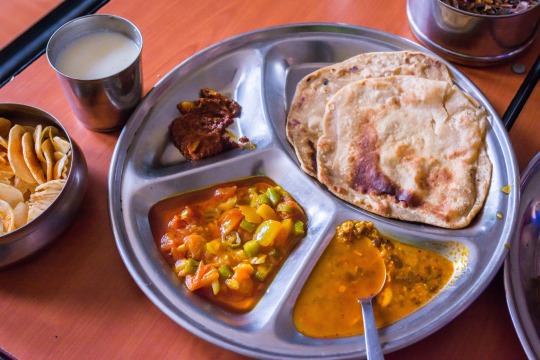#we’ve changed our menu! now there are fewer vegetarian options and they’re more expensive too
Explore tagged Tumblr posts
Text
places on campus stop changing your menus challenge
#we’ve changed our menu! now there are fewer vegetarian options and they’re more expensive too#falafel bowl with the driest falafel I’ve had in my life :(#maddening too because like. this is la and there’s great mediterranean food everywhere you look except apparently on campus#and I wouldn’t even have needed to come to campus and buy food if not for the construction with jackhammers at my apartment#anyways I’m in a mood today and it’s still 100 degrees which isn’t helping
10 notes
·
View notes
Text
What's it Like to Travel in Oman?

I wanted Oman to be exotic. To not desire anywhere else we’d been before (a challenge after eight years on the road). Maybe almost slap-you-in-the-face India different, but pleasantly bewildering Japan different.
When we received Muscat airport it did feel unfamiliar initially. The locals wear ankle-length gowns—white dishdasha with turbans for men and black abaya for ladies. the toilet featured squat toilets and was a busy mess of girls chattering in Arabic.
Then we walked into the arrival hall and were greeted with a Costa coffee and WH Smiths, two British chains that we rarely see outside the united kingdom.
Oman may be a modern, wealthy country. it's going to have only gained its wealth with oil money within the 1970s and been closed to tourists until the 1980s, but in Muscat, you'll now find Pizza Hut and Starbucks and supermarkets stocked all our favorite British chocolates, alongside the shiny mosques, bustling souqs, and straightforward Indian cafes.
I was a touch disappointed by this initially. Muscat felt very easy and not the exotic destination I’d hoped for. Simon, on the opposite hand, took comfort within the familiar and happily gorged on bags of Minstrels and Toffee Crisp Bites, treats we hadn’t had for a year.
Despite its modernization, Oman isn’t all chain restaurants and shopping malls, and that we found that the further faraway from the towns we traveled, when Starbucks was replaced by basic coffee shops and goats grazed by the side of the road, the more we enjoyed it.

I find Oman harder to explain than other places we’ve visited, perhaps because we struggled to urge under its skin on a brief trip, perhaps because it's fewer obvious attractions than more popular destinations. I even have no snappy answer to the question of what Oman was like, but here are our impressions after a 10-day road trip around the north of the country.
Where is Oman? The Sultanate of Oman isn’t a well-known tourist destination so you would possibly be wondering where exactly it's. Oman is found on the Arabian Peninsula and shares borders with the United Arab Emirates to the northwest, Saudi Arabia to the west, and Yemen to the southwest.
It’s Easy and Safe We found Oman a simple country to travel in, but you are doing need a car as conveyance is restricted. many of us speak English; the roads are generally quiet, tarmacked, and in good condition; and crime rates are very low. We felt safe and never worried about theft or scams or experienced any hassle. Oman is one of the foremost stable countries to travel within the Middle East.
Muscat isn't Dubai
Despite the large highways and shopping malls, Muscat may be a low key capital with none of the glitz or skyscrapers of neighboring Dubai. the town is extremely opened up between the jagged mountains and therefore the sea. the flamboyant houses, upmarket restaurants, and long stretch of beach of the diplomatic area Qurum feel very different from a budget Indian restaurants, busy shopping streets, and medieval forts along the corniche of Mutrah. There aren’t many major attractions but the Sultan Qaboos Grand Mosque does live up to its name and is one among the simplest places to go to in Oman.
People Oman may be a Muslim country so you’ll see many mosques hear the decision to prayer five times each day (expect to be woken at dawn), and won’t find alcohol in most restaurants and shops. 46% of the 4.5 million population are expatriates, primarily from the Indian Subcontinent.
We found the people friendly but fairly reserved, especially the ladies who didn’t usually acknowledge us, while men in villages and on hikes would say hello. I'm wondering if this can are different if I were traveling alone.
Oman is an absolute monarchy. Sultan Qaboos bin Said al Said has been ruling the country since 1970—the third-longest current reigning monarch within the world. He rose to power after overthrowing his father and proceeded to finish Oman’s isolation and make huge changes to modernize and develop the country by building schools, hospitals, ports, and a road and telecommunications network.
Landscape and Towns Oman is 82% desert and that we experienced it in many forms from the rolling dunes of Wahiba Sands to the rocky barren mountains around Nizwa and therefore the sandy beaches of Sur. Goats, camels, and donkeys are often seen wandering by the side of the road in additional rural areas.

Most of the towns are fairly modern and not particularly attractive. There are many aged mud hut villages you'll visit, but most are abandoned and are in ruins. Misfat Al Abriyeen is one of the few that are still inhabited.
I loved the matter-of-fact shop signs in Oman proclaiming their purpose like “sell foodstuffs”.
If you're a lover of forts, you’ll love Oman as every town has one among these sandcastle-like buildings, many many years old.
One of our favorite things about Oman was the oases that hack the bleakness of the desert with patches of vibrant green date palms.
Some of the oases are found in wadis—dry ravines which sometimes contain glorious swimming holes of emerald water like at the stunning Wadi Bani Khalid.
Food Oman doesn’t have a robust food culture and traditional Omani food mostly consists of meat and rice. Despite this, it’s easy to be vegetarian as most restaurants serve either Indian food, where there's always dahl and vegetable curries or Arabic/Turkish food with hummus, salads, flatbread and other mezze on offer.

We were proud of the straightforward meals we ate, but it isn’t a foodie destination, and there aren’t many stand-out restaurants. the foremost commonplace to eat maybe a basic cafe serving fast-food dishes with aspirational menus—they usually didn’t have everything on the menu but we're happy to suggest vegetarian options for us.
Surprisingly Oman does have fantastic supermarkets. We loved Lulu Hypermarket and once we had an apartment in Nizwa we self-catered from the prepared food section with dahl, curries, salads, hummus, bread then far more. it had been better and cheaper than most restaurants.
One culinary enjoyment of Oman is dating, which is grown there. they're cheap and delicious and served with traditional Omani coffee in tiny cups.
It’s Quite Expensive Oman has made the conscious decision to focus on the upper-end travel market instead of backpackers. We found accommodation particularly expensive, especially considering everywhere we stayed in was functional instead of special. the foremost interesting place we stayed was the straightforward but atmospheric Desert Retreat Camp in the Wahiba Sands.
Some gorgeous new hotels are opening up as tourism increases, just like the Alila Jabal Akhdar, but you've got to pay many pounds an evening for any style.
We spent £134 ($173/€145) each day for 2 people with 51% of our budget on accommodation. We found food inexpensive outside hotels and it cost us but £14 each day (not including the meals that were included in two of our hotels), petrol is a smaller amount than 40p a liter, and our favorite activities—hikes and wadis—were free.
The cheapest thanks to traveling Oman would be to wild camp free of charge because it is legal in most of the country.
It’s Not Busy But Tourism is Growing It’s easy to urge off the beaten track in Oman. We visited in peak season and traveled the foremost common tourist route, but there have been still only a couple of foreign tourists at the main sights—usually, older Europeans (British, French, German, Italians) traveling as a few with a guide/driver or in small tour groups. There was just one other guest at our desert camp and that we had two of the foremost popular hikes within the country to ourselves by starting at 8 am. If you stray just a touch from the favored attractions you’ll be the sole foreigner around.
Tourism in Oman is growing, though, so now's the time to go to.
What to Wear in Oman Locals dress modestly and visitors must do too—there’s no got to cover your hair (except women when visiting mosques), but both men and ladies should cover their shoulders and knees, and in additional conservative areas I preferred to hide my arms and legs too. I usually wore linen trousers or jeans and a loose sleeve shirt.
The weather in Oman in December was perfect—about 25ºC and sunny during the day, with cooler nights. you're doing need warm clothes if you are rising the mountains—the nights on Jebel Shams were on the brink of freezing.
Do We Recommend Visiting Oman? Yes, we recommend visiting Oman. If it’s your first visit to the center East, I might probably recommend Jordan instead because it has more major sights and better food. But if you're looking to urge off the beaten track during a safe country Oman may be a great choice. If you're a lover of desert, forts, wild camping, and adventurous 4WD trails, Oman would be perfect.
1 note
·
View note